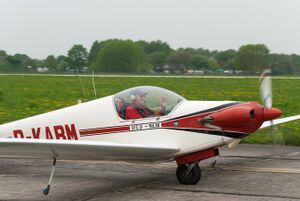Engineering:Sportavia-Pützer SFS 31 Milan
| SFS 31 Milan | |
|---|---|

| |
| SFS 31 | |
| Role | Motor glider |
| National origin | Germany |
| Manufacturer | Sportavia-Pützer (de) Scheibe Flugzeugbau |
| First flight | 31 August 1969[1] |
| Number built | 14 by 1973[1] |
| Developed from | Fournier RF 4 Scheibe SF-27 |
The Sportavia-Pützer SFS 31 Milan is a single-seat motor glider that was produced in Germany in the early 1970s.
Design and development
The Milan was created by essentially combining the fuselage of the Fournier RF 4 with the wings of the Scheibe SF-27.[2][3][4] The resulting aircraft is a conventional motorglider design, a low-wing cantilever monoplane with a nose-mounted engine.[1][4] The undercarriage consists of a single retractable mainwheel, a fixed tailwheel, and an outrigger under each wing.[1][5] Construction is of wood, skinned in plywood and fabric.[1][5] The designation was created by combining the initials of the manufacturers involved (Sportavia-Pützer (de), René Fournier (aircraft designer) (fr) , and Scheibe), and adding the sum of the model numbers of the two constituent aircraft designs.[1][4]
The SFS 31 prototype (registered D-KORO) first flew on 31 August 1969[1][4] and soon replaced the RF 4D in production at Sportavia-Pützer.[6] In 1971, Hans Huth piloted an SFS 31 to third place in the German national motorglider competition.[1][7]
Specifications
Data from Taylor 1977, p.560, except as noted
General characteristics
- Crew: one pilot
- Length: 6.05 m (19 ft 10 in)
- Wingspan: 15.00 m (49 ft 3 in)
- Height: 1.57 m (5 ft 2 in)
- Wing area: 12.0 m2 (129 sq ft)
- Aspect ratio: 18.6
- Airfoil: Wortmann FX-61-184 at root, Wortmann FX-60-126 at tip
- Empty weight: 310 kg (683 lb)
- Gross weight: 440 kg (970 lb)
- Powerplant: 1 × Rectimo 4 AR 1200 , 29 kW (39 hp)
Performance
- Cruise speed: 180 km/h (112 mph, 97 kn)
- Range: 670 km (415 mi, 361 nmi)
- Service ceiling: 6,000 m (19,700 ft)
- Maximum glide ratio: 29:1[5]
- Rate of climb: 3.0 m/s (590 ft/min)
Notes
References
- Hardy, Michael (1982). Gliders & Sailplanes of the World. London: Ian Allan.
- "Hanover Report". Flight International: 713–22. 30 April 1970. http://www.flightglobal.com/pdfarchive/view/1970/1970%20-%200785.html. Retrieved 2011-03-13.
- Ross, Peter (1 July 1971). "Soaring to Power". Flight International: 14–15. http://www.flightglobal.com/pdfarchive/view/1971/1971%20-%201108.html. Retrieved 2011-03-13.
- Simpson, R.W. (1995). Airlife's General Aviation. Shrewsbury: Airlife.
- Taylor, John W.R. (1974). Jane's All the World's Aircraft 1973–74. London: Jane's Yearbooks.
- Taylor, Michael J. H. (1989). Jane's Encyclopedia of Aviation. London: Studio Editions.
 |

